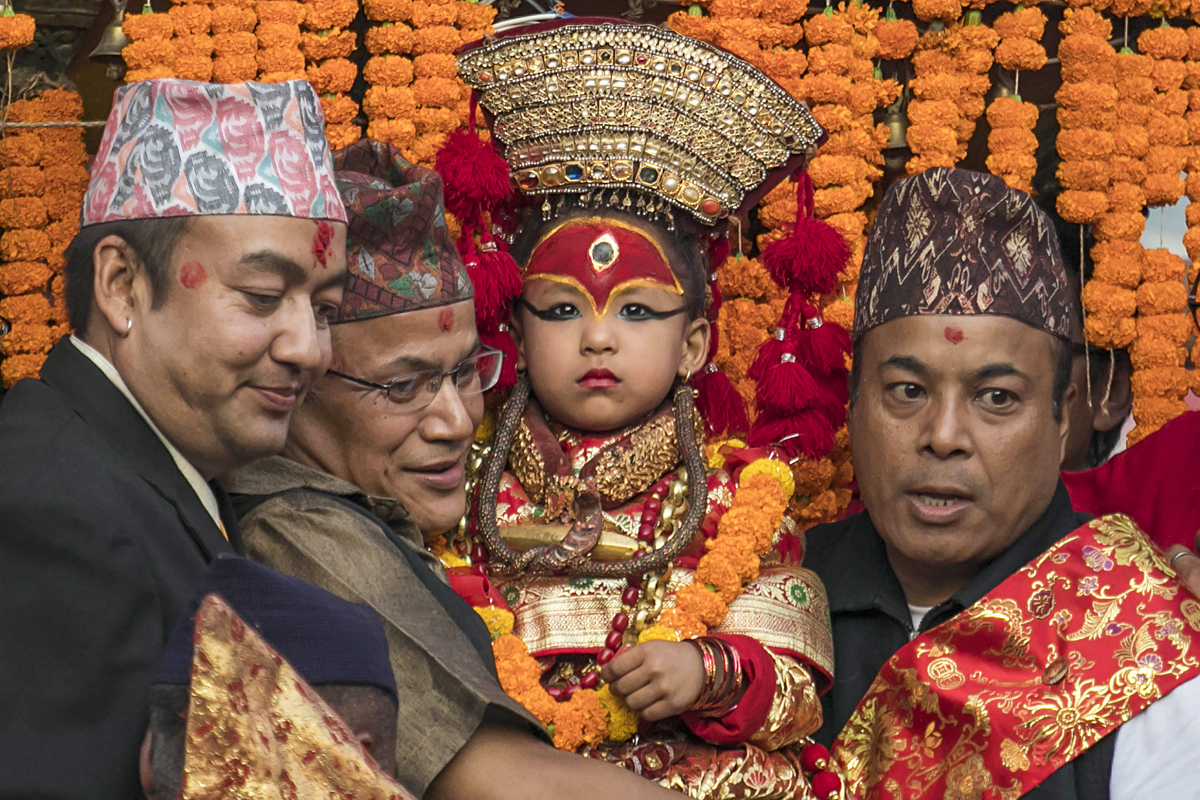The Newari people have lived in the Kathmandu valley since prehistoric times and they are an interesting mix of Buddhist and Hindu. Essentially they’re Buddhists who have adopted the Hindu caste system, and have also adopted a Hindu goddess, Durga, who they believe lives in the body of a chosen little girl, the Kumari.

Rather like a choirboy or Macaulay Culkin, once the Newari reaches puberty she’s considered to have outlived her usefulness. She’s pensioned off and there’s a scramble by the five senior Buddhist priests to find a replacement.
The selection process is rather unusual. The child must be from the Shakya caste of Buddhists and must be between three and five years of age. She must be in excellent health and never have shed any blood. She must be a quiet child of a solemn disposition, who has not yet lost any teeth.
Once they’ve drawn up a shortlist of little girls, they then scrutinise each one to see if she contains The Thirty-Two Perfections. These include:
- a chest like a lion
- eyelashes like a cow
- a neck like a conch shell
- a body like a banyan tree
- thighs like a deer
- a voice as soft and clear as a duck
It seems to me that the criteria must be open to very loose interpretation, as any child genuinely blessed with all these attributes would be top of the list for corrective surgery and voice coaching classes.
Once the priests have selected their preferred candidate there is one final test. She has to spend a night in a candlelit room with the heads of a hundred and eight buffaloes and goats. This sounds bad enough, but in addition to the heads – no indication is given as to whether these are skulls or freshly severed and still dripping blood – there are also masked men making scary noises, and the girl mustn’t show any fear. Bearing in mind that this child is about four years old, I’m amazed that they ever managed to find one Kumari, let alone an unbroken succession of them for years and years. Nepalese girls must be a lot sassier than European ones.
Of course, once I’d learnt all about her I was very keen to see this unusual child, and we headed off to her palace, the Kumari Ghar, which is in Durbar Square, a World Heritage Site. It was built in 1757 and has beautifully carved wooden reliefs, doorways and statues. Its status as a holy building was confirmed for many devotees after the 2015 earthquake, as it was the only building in the area which remained standing. However, architects believe this is probably due to its squat, solid shape, rather than any divine intervention.
Tourists go into the main courtyard and hang around, hoping that the Kumari will appear in the upstairs window, which she does intermittently. So we muscled our way in past the bouncer on the door and sat around for a bit, admiring the woodwork.


After a while we realised that she wasn’t going to appear. As the rules say that she’s not allowed to walk and has to be carried everywhere, her minders probably get a bit tired of lugging her over to the window and holding her up for everyone to gawp at. And so I’d like to suggest an addition to The Thirty-Two Perfections (now Thirty-Three …):
- she must be as small as a mongoose and as light as a banyan leaf.


It was a bit disappointing not to see her after all the hype, but then I read up a little about the sort of predictions she gives:
- If she smiles at you, you’re going to die soon.
- If she laughs loudly, you’re going to be very ill or die … or perhaps both.
- If she picks at food offerings you bring, you’re going to lose all your money.
- If she trembles, you’re going to be sent to prison.
- If she cries, your death is imminent.
And, you know what – I couldn’t help feeling that I’d had a lucky escape.
